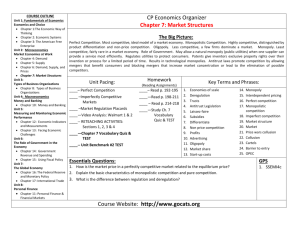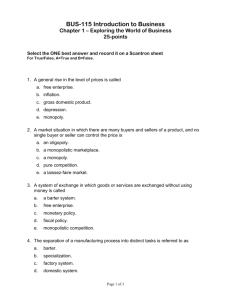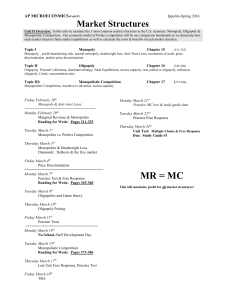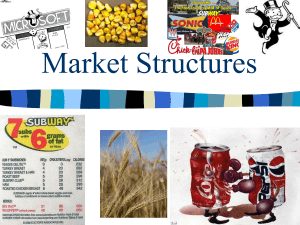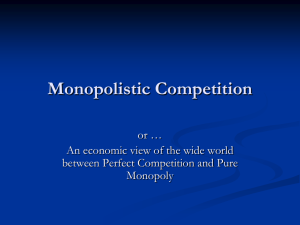Answers Chapter 7 Market Structure
advertisement
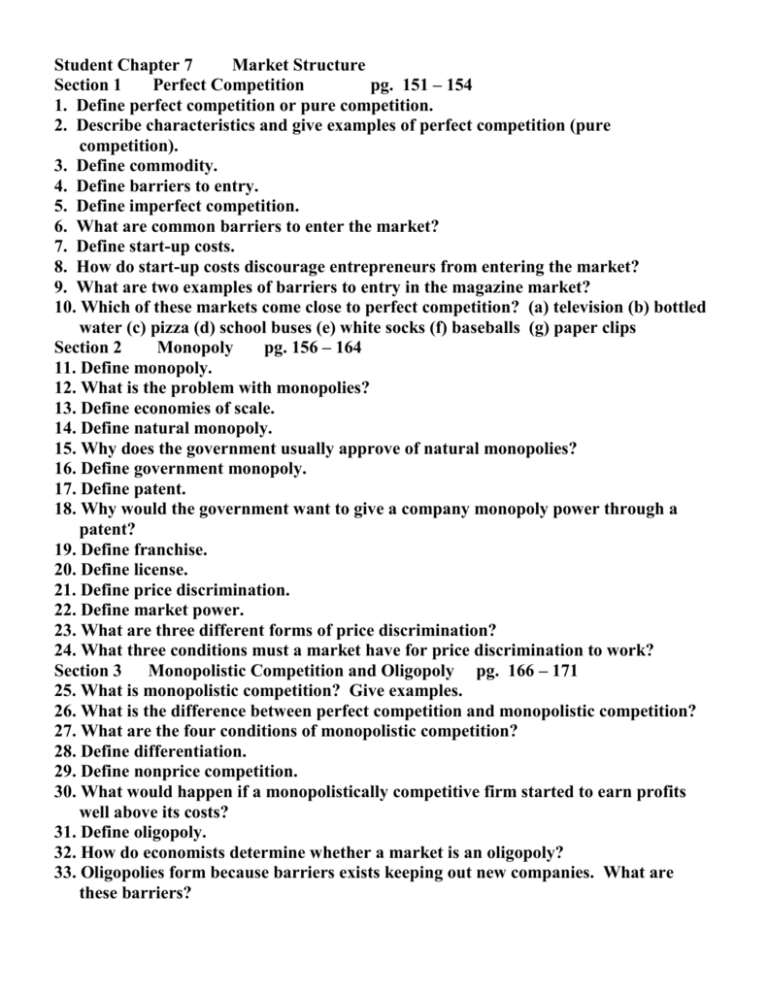
Student Chapter 7 Market Structure Section 1 Perfect Competition pg. 151 – 154 1. Define perfect competition or pure competition. 2. Describe characteristics and give examples of perfect competition (pure competition). 3. Define commodity. 4. Define barriers to entry. 5. Define imperfect competition. 6. What are common barriers to enter the market? 7. Define start-up costs. 8. How do start-up costs discourage entrepreneurs from entering the market? 9. What are two examples of barriers to entry in the magazine market? 10. Which of these markets come close to perfect competition? (a) television (b) bottled water (c) pizza (d) school buses (e) white socks (f) baseballs (g) paper clips Section 2 Monopoly pg. 156 – 164 11. Define monopoly. 12. What is the problem with monopolies? 13. Define economies of scale. 14. Define natural monopoly. 15. Why does the government usually approve of natural monopolies? 16. Define government monopoly. 17. Define patent. 18. Why would the government want to give a company monopoly power through a patent? 19. Define franchise. 20. Define license. 21. Define price discrimination. 22. Define market power. 23. What are three different forms of price discrimination? 24. What three conditions must a market have for price discrimination to work? Section 3 Monopolistic Competition and Oligopoly pg. 166 – 171 25. What is monopolistic competition? Give examples. 26. What is the difference between perfect competition and monopolistic competition? 27. What are the four conditions of monopolistic competition? 28. Define differentiation. 29. Define nonprice competition. 30. What would happen if a monopolistically competitive firm started to earn profits well above its costs? 31. Define oligopoly. 32. How do economists determine whether a market is an oligopoly? 33. Oligopolies form because barriers exists keeping out new companies. What are these barriers? 34. What three practices represent ways that firms in an oligopoly can try to control a market? 35. Define price war and who benefits? 36. Define collusion. 37. Define price fixing. 38. How would price fixing and collusion help producers? 39. Define cartel. Section 4 Regulation and Deregulation pg. 172 -176 40. Define predatory pricing. 41. How does predatory pricing hurt competition? 42. Define trust. 43. What is the purpose of antitrust laws? 44. Define merger. 45. Under what conditions will the government approve a merger? 46. Define deregulation. Study Guide Chapter 7 Perfect competition Describe characteristics of perfect competition Barriers of entry Start-up costs How do start-up costs discourage entrepreneurs from entering the market? Perfect competition vs monopoly prices Monopoly Economies of scale Natural monopoly Why does the government usually approve of natural monopolies? Patent Why would government want to give a company monopoly through a patent? Franchise License Price discrimination Market power What is monopolistic competition? Differentiation Nonprice competition What would happen if a monopolistically competitive firm started to earn profits well above its costs? Oligopoly How do economists determine whether a market is an oligopoly? Price war and who benefits Cartel Trust Merger Deregulation


